In his series of WW1 epitaphs, Rudyard Kipling comments on the all too common fate of a new soldier at the front who – curious about the enemy – cannot resist taking a look and unwittingly exposes his head to a sniper.
Stand up to watch it well.)
The physical injuries were compounded by the psychological and the trauma of their distorted appearance. Who was that person in the mirror? Would children point and stare or run away and would strangers turn away in revulsion? How would friends and families react?Here is the poet Sarah White writing of just such an encounter. But this is not the aftermath of WW1 but the consequence of another of the endless wars ever since.
…inscribed with our human likeness
A veteran who has lost his face
boards my subway car.
I wish I had come home another way.
I can’t decide where I should look
as the veteran boards my subway car
and brings the war closer to home
I can’t decide where I should look
or how to read amorphous spaces
close to home as I face him and the war
Where there should be lashes, nostrils, lips
I read amorphous spaces
He holds a coffee can in case I want to help
Without lashes, nostrils, lips
It’s difficult for him to speak
He holds a coffee can. I want to help
Here’s my money with my dread and my distaste
It’s amazing that he manages to speak
I can imagine his despair
He takes my money with my fear and my distaste.
He must be searching for a place to go
Imagine the despair
Since the day he lost his face
he has been searching for a place to go
on Earth, the very planet
where he lost his face
He’d do better on a satellite or star
instead of Earth, the planet
where the VA clinics are, and the wars
There would be mercy on a satellite or star
for a veteran who lost his face
He’s had enough of clinics, wars, and
the woman staring in the subway car.
– Sarah White from her collection Wars Don’t Happen Anymore (2015)
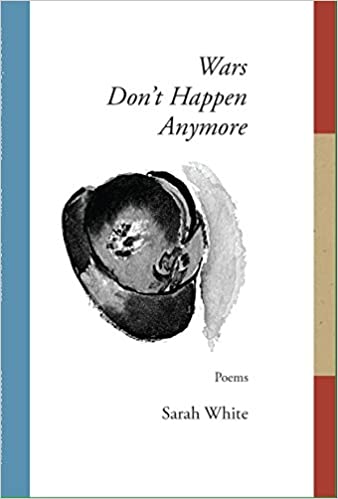 It’s been three years since Sarah gave me that book and I sat and read it from cover to cover.
It’s been three years since Sarah gave me that book and I sat and read it from cover to cover.
I was impressed by the power of the poems – awed by their range, and how personal and moving they felt.
I chose …inscribed with our human likeness because at that time I was putting together a post about Anna Coleman Ladd for the Women Artists of WW1 series. I never completed it.
A chance meeting with Sarah at the elevator this afternoon brought the post back to mind.
And so here – revised and much shortened – it is.
The Tin-Noses Shop
When America entered the war in 1917, Ladd was a successful and fashionable sculptor living in Boston. She was married to a pediatrician and had two daughters. She was well known as the creator of fountain pieces, portrait busts, and reliefs. She was also a published novelist. She had solo exhibitions in New York, Washington D.C, and in her hometown of Philadelphia. She had completed portrait busts of Anna Pavlova and Ethel Barrymore.
She involved herself in volunteer war work. And then she read about the “Tin Noses Shop”. This was the nickname given to a London hospital ward initiated by artists and dedicated to creating facial masks to conceal horrific facial injuries.
An estimated 60,500 British soldiers suffered head or eye injuries and they often faced protracted reconstruction surgery in an attempt to restore their mutilated facial features. The sculptor Francis Derwent Wood had proposed portrait-masks after working as an orderly with the RAMC at the 3rd London General Hospital in Wandsworth in 1915. The result was the Masks for Facial Disfigurement Department, aka the Tin Noses Shop. It offered some hope.
When Ladd read an account of these artists she was inspired to move to Paris and set up her own studio to sculpt new faces for men who had lost parts of their own in the war.
She founded the American Red Cross Studio for Portrait-Masks making cosmetic masks for the badly disfigured.
In the space of eighteen months, Ladd and her colleagues sculpted almost one hundred labor-intensive masks. Each took about a month to create. The Red Cross funding ended with the war and Ladd closed the studio. She returned to Boston and resumed her work as a sculptor. Her work earned her the Légion d’Honneur Crois de Chevalier and the Serbian Order of Saint Sava.
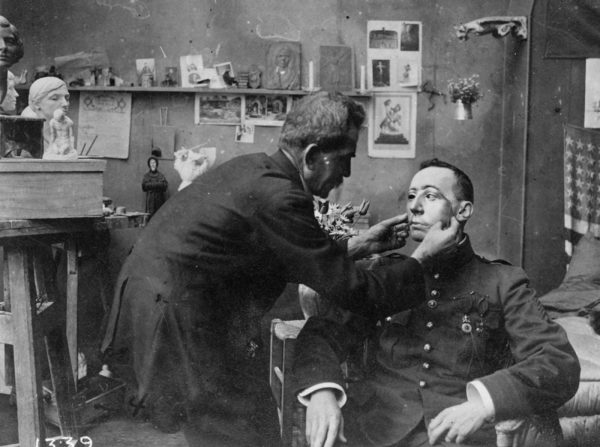
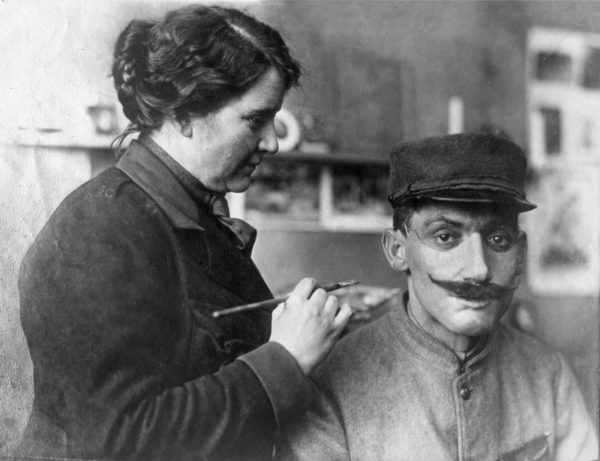
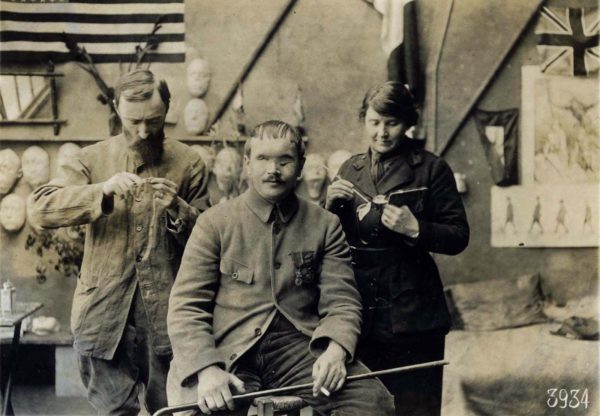
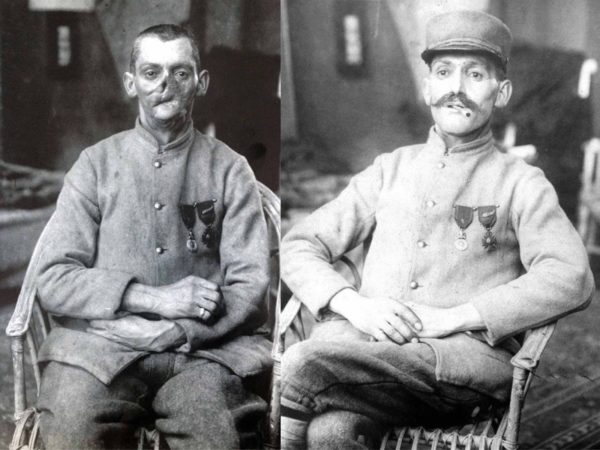
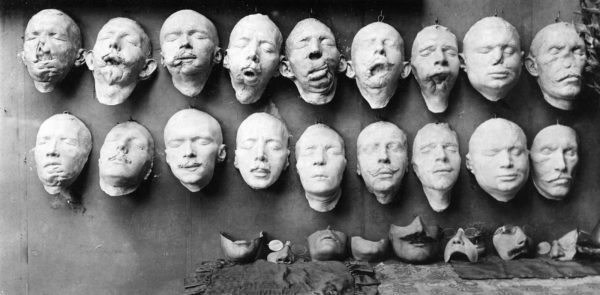
Sarah White’s extraordinary poetry bears witness to the long history of the wars to which we have become addicted. I highly recommend laying your hands on a copy of her collection Wars Don’t Happen Anymore.



An excellent read!! Thank you for this!
That’s a terrific (and terrifying) poem. It brings home to all of us the hypocrisy of those (us) who send young people off to war but cannot abide the consequences. This poet has the courage to tell us the truth about herself and ourselves. Thank-you Sarah White!
Agreed on all of that. It is a remarkable poem. The whole collection is quite terrific and full of surprises.
Thank you Josie. Another reminder of the horrors of war And I don’t think those soldiers were looked after at all by the Government on their return. I always remember Septimus Warren Smith in Mrs Dalloway as an example of this.
Looked after they certainly were not. The Septimus Warren Smiths of post-WW1 UK were all too common – unemployed, damaged, victims and sufferers and without the homes fit for heroes they were promised. It would take another war – and the thorough defeat of the Conservatives in 1945 – to usher in a welfare state that at least made the effort to create a fairer and more caring society.
How awful to survive the appalling injury only to become shunned. I don’t recall ever seeing anyone with war wounds, but I did see lepers and of course people had the same reaction to them. Examining my own conscience, I ask myself why it is so difficult when looking at someone who has some kind of “disfigurement”, a port-wine stain birthmark comes to mind…it’s not a matter of being repulsed but of not wanting the person in question to be offended…at least that’s what I like to think. In truth there is always going to be a level of discomfort and when it’s a wounded serviceman, there is a lot more to it. The poem expresses it all.
It’s complicated, right? There’s guilt and shame and curiosity and embarrassment and anxiety just for starters. And then we project whatever rises to the surface onto the “other’ whose feelings and thoughts may be quite otherwise than we imagine them to be. I’m also thinking about Siegfried Sassoon’s bitter and angry “Does it matter?”
Does it matter?—losing your legs?…
For people will always be kind,
And you need not show that you mind
When the others come in after hunting
To gobble their muffins and eggs.
Does it matter ?—losing your sight?…
There’s such splendid work for the blind;
And people will always be kind,
As you sit on the terrace remembering
And turning your face to the light.
Do they matter?—those dreams from the pit?…
You can drink and forget and be glad,
And people won’t say that you’re mad;
For they’ll know you’ve fought for your country
And no one will worry a bit.
That’s knocked me sideways, Josie
Thank. you for this post. I knew nothing about this artist or this undertaking. So many horrors on this planet which we know about (war, slaughterhouses, environmental catastrophes) but are reluctant to see — or remain in total denial about… The before and after photos are very moving. As is Ms. White’s poem.
Thanks Will. I think it’s a powerful poem – honest and raw. And stylistically rather interesting too – the way it loops back on itself.
Very interesting Josie, thank you. As a soldier I saw more horrific injuries than I care to remember. Each case is, of course, individual, as is the recipients reaction to their disfigurement. It is always difficult for the “gazer” and I’ve experienced how wonderfully some young children accept what they see with no embarrassment and no revulsion, and will openly question if anything troubles, or confuses them. A good, healthy, and very acceptable attitude which we mostly lose as we get older.
As to soldiers (and any other body of men and women who may suffer such injuries), humour plays a very large part in coping. I will not recount examples as they may be seen to be totally inappropriate.
Thanks for those observations Peter. And yes – I think you are right about children – once that it the protective adults get over their embarrassment of the truth being seen and spoken.
And humour. Yes. Starting with – in this case – with the nickname Tin Noses.
A fascinating post, Josie! Thank you 💐💐🙋♂️
Ashley´s last blog post ..Ghost Forest
Dear Josie,
I would like to commend you highly for your superb writing here. Thank you very much for edifying us on Anna Coleman Ladd, who had contributed so much through her facing sculpting, and also for your mention of and chance encounter with Sarah White in relation to her 2015 collection entitled “Wars Don’t Happen Anymore”.
By the way, accessing my bespoke blog should be trouble-free if you could visit it in situ (not via WordPress Reader) on a decent desktop or laptop computer. If the screen were to flicker or freeze, then the quality of the computer and/or the screen is insufficient, thus requiring something better. I look forward to interacting with you on your next visit.
Happy August to you!
Yours sincerely,
SoundEagle
Thanks SoundEagle. I will give it another go!
You are very welcome, Josie.
There is a typo in my previous comment. I meant “face sculpting” not “facing sculpting”.
Yours sincerely,
SoundEagle
I think the fact that I always have a gazillion pages open is part of the problem.
Interesting that they survived all of that back in those days. I am sure the masks were a Godsend.
The intentions were admirable. The reactions of the recipients varied. But in the end, perhaps it is the reactions of the gazers that is the most significant. We – the gazers – know all about the horror of war we tell ourselves. But we do not want to “see’ it.
No plastic surgery back then or it was not what they can do today. I’m sure people were more horrid to soldiers in that situation in that time period than they are now.